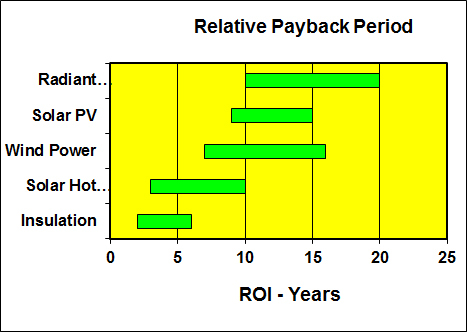Incentives and Return on Investment
Until 2016—Federal and local incentives have been expanded to make a solar energy investment earn a reasonable ROI. Residential tax credits for solar (PV) electricity, solar hot water /heating are now 30% of the installed cost with no cap.
Commercial solar incentives are even better. The 30% tax credit applies to solar PV, wind turbines and solar hot water with no cap. The Modified Accelerated Cost-Recovery System (MACRS) reduces cost to almost 50 cents on the dollar. Renewable Energy Credits ”RECs” are issued on the energy produced and can be sold. Call to capitalize on an opportunity today.
For a comprehensive look at federal and local incentives go to: Dsireusa.org
The chart below shows the relative payback periods for four applications of renewable energy. While not an application, we have added Insulation to indicate that the most cost effective action one can take in heating applications is to first insure that your house is well insulated before investing in a solar heating system. Similar actions apply to approaches for conservation of electricity and the use of energy star appliances before investing in a expensive PV or off grid system.
Until 2016—Federal and local incentives have been expanded to make a solar energy investment earn a reasonable ROI. Residential tax credits for solar (PV) electricity, solar hot water /heating are now 30% of the installed cost with no cap.
Commercial solar incentives are even better. The 30% tax credit applies to solar PV, wind turbines and solar hot water with no cap. The Modified Accelerated Cost-Recovery System (MACRS) reduces cost to almost 50 cents on the dollar. Renewable Energy Credits ”RECs” are issued on the energy produced and can be sold. Call to capitalize on an opportunity today.
For a comprehensive look at federal and local incentives go to: Dsireusa.org
The chart below shows the relative payback periods for four applications of renewable energy. While not an application, we have added Insulation to indicate that the most cost effective action one can take in heating applications is to first insure that your house is well insulated before investing in a solar heating system. Similar actions apply to approaches for conservation of electricity and the use of energy star appliances before investing in a expensive PV or off grid system.
The range of payback periods varies greatly among applications. There is no one single answer. Your payback period depends on your particular situation. If full advantage is taken for all tax credits and incentives, energy use is high, cost of local energy is high and there is relative ease of implementation, your particular ROI is much shorter. On the other hand if you live in a region where energy is relatively cheap, use marginally small amounts of energy, have high labor costs or a degree of implementation difficulty your ROI may be much longer. In any event the best ROI is for Solar Hot Water. Prices range from $2950 for the do-it-yourselfer and up.
New Utility Rebate Programs
Call for an Estimate and Site Evaluation today.
(775) 833-4559
New Utility Rebate Programs
Call for an Estimate and Site Evaluation today.
(775) 833-4559


